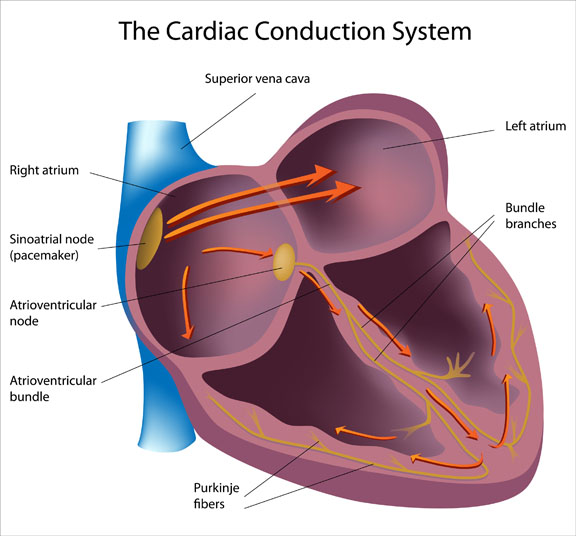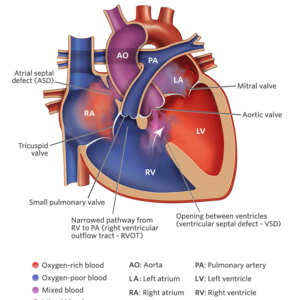Description
Familiarity with treatment
The Maze procedure is a surgical treatment for atrial fibrillation, a type of arrhythmia characterized by irregular and rapid heartbeats in the atria (upper chambers of the heart). It is typically performed during open-heart surgery, such as coronary artery bypass grafting or valve repair/replacement.
During the Maze procedure, a series of carefully placed incisions or ablations are made in the atrial tissue to create a pattern of scar tissue. This scar tissue disrupts the abnormal electrical pathways that cause atrial fibrillation and redirects the electrical signals through a specific pathway, restoring a normal heart rhythm.
The Maze procedure can be performed using different techniques, including the traditional cut-and-sew method or minimally invasive approaches using radiofrequency or cryoablation. The choice of technique depends on various factors, including the patient’s specific condition and the surgeon’s expertise.
The Maze procedure has been shown to be highly effective in treating atrial fibrillation, with success rates ranging from 80% to 95%. It can significantly improve symptoms, restore a normal heart rhythm, and reduce the risk of stroke and other complications associated with atrial fibrillation.
Who is it suitable for?
The Maze procedure is typically considered for individuals with atrial fibrillation (AF) who have not responded well to other treatment options or who require concomitant cardiac surgery, such as valve repair or coronary artery bypass grafting. It may be suitable for individuals who meet the following criteria:
- Symptomatic Atrial Fibrillation: The Maze procedure is generally recommended for individuals with symptomatic AF, meaning they experience bothersome symptoms such as palpitations, shortness of breath, fatigue, or dizziness.
- Failed Medical Management: The procedure may be considered for individuals who have not achieved adequate control of their AF symptoms with medications or other non-surgical treatments, such as antiarrhythmic drugs or catheter ablation.
- Persistent or Long-Standing Atrial Fibrillation: The Maze procedure is often recommended for individuals with persistent or long-standing AF, which refers to AF that has been present for an extended period of time or is difficult to convert to a normal heart rhythm.
- Concomitant Cardiac Surgery: The Maze procedure is commonly performed in conjunction with other cardiac surgeries, such as valve repair or coronary artery bypass grafting. It may be suitable for individuals who require these additional procedures and have coexisting AF.
- Good Overall Health: The Maze procedure is a major surgical procedure that requires general anesthesia and carries some risks. It is typically recommended for individuals who are in good overall health and can tolerate open-heart surgery.
Who is it not suitable for?
The Maze procedure may not be suitable for everyone with atrial fibrillation (AF). There are certain factors that may make an individual not suitable for the procedure. These factors include:
- Minimal or Asymptomatic AF: The Maze procedure is typically recommended for individuals with symptomatic AF, meaning they experience bothersome symptoms such as palpitations, shortness of breath, fatigue, or dizziness. If an individual has minimal or no symptoms from their AF, the risks and invasiveness of the Maze procedure may outweigh the potential benefits.
- High Surgical Risk: The Maze procedure is a major surgical procedure that requires general anesthesia and carries some risks. Individuals who have significant comorbidities or are at high risk for surgical complications may not be suitable candidates for the procedure.
- Advanced Age: Advanced age alone does not necessarily exclude someone from being a candidate for the Maze procedure. However, older individuals may have a higher risk of surgical complications, and the potential benefits of the procedure should be carefully weighed against the risks in this population.
- Limited Life Expectancy: If an individual has a limited life expectancy due to advanced age, significant comorbidities, or other factors, the potential benefits of the Maze procedure may not outweigh the risks or the time required for recovery.
- Inability to Undergo Open-Heart Surgery: The Maze procedure is typically performed during open-heart surgery, which requires a sternotomy (incision in the chest) and the use of a heart-lung bypass machine. Individuals who are unable to undergo open-heart surgery due to medical reasons or contraindications may not be suitable candidates for the Maze procedure.
Advantages
The Maze procedure offers several advantages for individuals with atrial fibrillation (AF) who are suitable candidates for the procedure. Some of the advantages include:
- Restoring Normal Heart Rhythm: The primary goal of the Maze procedure is to restore a normal heart rhythm in individuals with AF. By creating a pattern of scar tissue in the atria, the procedure disrupts the abnormal electrical pathways that cause AF and redirects the electrical signals through a specific pathway. This can effectively restore a normal heart rhythm and eliminate or significantly reduce AF episodes.
- Symptom Improvement: AF can cause bothersome symptoms such as palpitations, shortness of breath, fatigue, and dizziness. By restoring a normal heart rhythm, the Maze procedure can alleviate these symptoms and improve the overall quality of life for individuals with AF.
- Reduced Stroke Risk: AF increases the risk of blood clots forming in the atria, which can lead to stroke. By restoring a normal heart rhythm, the Maze procedure can reduce the risk of blood clots and lower the risk of stroke in individuals with AF.
- Long-Term Success: The Maze procedure has been shown to have high success rates in maintaining a normal heart rhythm. Studies have reported success rates ranging from 80% to 95% in eliminating or significantly reducing AF episodes. This long-term success can provide individuals with AF with lasting relief from symptoms and a reduced need for ongoing medication management.
- Concomitant Cardiac Surgery: The Maze procedure can be performed in conjunction with other cardiac surgeries, such as valve repair or coronary artery bypass grafting. This allows for the treatment of both the underlying cardiac condition and AF in a single surgical procedure, reducing the need for additional interventions and potentially improving overall outcomes.
- Potential for Medication Reduction: Following a successful Maze procedure, some individuals may be able to reduce or even eliminate the need for antiarrhythmic medications or anticoagulants (blood thinners) that are commonly used to manage AF. This can simplify medication regimens and reduce the potential side effects associated with long-term medication use.
Complications
Complications of the Maze procedure in arrhythmia surgery are generally rare but can occur. Here are some potential complications mentioned in the search results:
Bleeding: Bleeding can occur during or after the procedure. In some cases, additional interventions or blood transfusions may be necessary to address excessive bleeding.
Blood Clots: The formation of blood clots is a potential risk after the Maze procedure. These clots can lead to serious complications such as stroke or heart attack. Blood-thinning medications may be prescribed to reduce the risk of clot formation.
Need for a Permanent Pacemaker: In some cases, the Maze procedure may disrupt the heart’s electrical conduction system, leading to the need for a permanent pacemaker to regulate the heart’s rhythm.
Complications from Anesthesia: As with any surgical procedure, there are potential risks associated with anesthesia, such as allergic reactions or adverse effects on breathing and blood pressure.
Failure to Control Abnormal Rhythms: While the Maze procedure is generally effective in restoring normal heart rhythm, there is a small possibility that it may not completely eliminate the abnormal rhythms. Additional treatments or procedures may be required in such cases.
Infection: Infection at the surgical site or in the heart can occur, although it is relatively rare. Antibiotics may be prescribed to reduce the risk of infection.
Other Abnormal Heart Rhythms: The Maze procedure itself can occasionally lead to the development of other abnormal heart rhythms, although this is uncommon.
Preoperative care
Preoperative care for the Maze procedure in arrhythmia surgery involves several important aspects to ensure the patient’s safety and optimize the surgical outcome. Here are some key points based on the search results:
Medical Evaluation: Before the Maze procedure, a comprehensive medical evaluation is conducted. This includes a review of the patient’s medical history, physical examination, and various tests to assess their overall health and suitability for surgery. These tests may include blood work, electrocardiogram (ECG), echocardiogram, and imaging studies.
Medication Management: The healthcare team will review the patient’s current medications and make any necessary adjustments. Some medications, particularly blood thinners, may need to be temporarily stopped or adjusted to minimize the risk of bleeding during and after the procedure.
Fasting and Preoperative Instructions: Patients are given specific instructions regarding fasting before the surgery. This typically involves avoiding food and drink for a certain period of time before the procedure to ensure an empty stomach. Clear instructions are provided regarding when to stop eating and drinking.
Informed Consent: Informed consent is an essential part of preoperative care. The healthcare team will explain the Maze procedure, its potential risks and benefits, and alternative treatment options. Patients will have the opportunity to ask questions and provide their consent for the surgery.
Preparing for Hospital Admission: Patients will receive instructions on what to bring to the hospital, including any necessary documents, medications, and personal items. They may also be advised to shower or bathe with a special antibacterial soap before the surgery to reduce the risk of infection.
Preoperative Counseling and Education: Patients will receive counseling and education about the Maze procedure. This includes information about what to expect during and after the surgery, potential risks and complications, and postoperative care instructions. Patients are encouraged to ask questions and address any concerns they may have.
Anesthesia Evaluation: A preoperative anesthesia evaluation is conducted to assess the patient’s suitability for anesthesia and to determine the most appropriate anesthesia plan for the procedure. This evaluation may involve a review of the patient’s medical history, physical examination, and additional tests if necessary.
Postoperative care
Postoperative care following the Maze procedure in arrhythmia surgery is crucial for a successful recovery. Here are some key points based on the search results:
Hospital Stay: After the Maze procedure, patients typically spend a few days in the hospital. The length of the hospital stay may vary depending on the complexity of the surgery and the patient’s response to postoperative care.
Pain Management: Pain and discomfort are common after surgery. The healthcare team will provide appropriate pain management strategies, which may include medications or other techniques to help alleviate pain.
Monitoring: Patients will be closely monitored in the hospital to assess their heart rhythm, blood pressure, oxygen levels, and overall recovery. This monitoring ensures early detection of any complications and allows for prompt intervention if needed.
Medications: Patients may be prescribed medications to manage pain, prevent infection, control heart rhythm, and reduce the risk of blood clots. It’s important to take these medications as prescribed and follow up with the healthcare team regarding any concerns or side effects.
Wound Care: Proper care of the surgical incisions is essential to prevent infection and promote healing. Patients will receive instructions on how to keep the incisions clean and dry, as well as when to follow up with the healthcare team for wound assessment.
Activity and Rehabilitation: Gradual resumption of physical activity is typically recommended after the Maze procedure. The healthcare team will provide guidance on when and how to start gentle exercises and gradually increase activity levels. Cardiac rehabilitation programs may be recommended to aid in recovery and improve overall cardiovascular health.
Follow-Up Visits: Regular follow-up visits with the healthcare team are important to monitor the patient’s progress, assess the effectiveness of the procedure, and make any necessary adjustments to medications or treatment plans. These visits also provide an opportunity to address any concerns or questions the patient may have.






Reviews
There are no reviews yet.